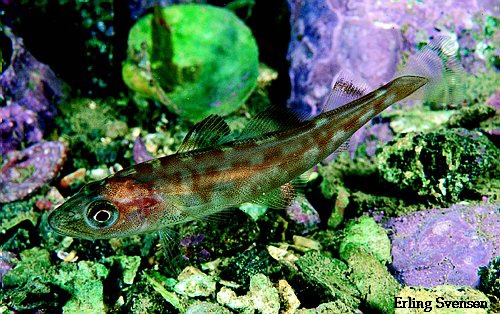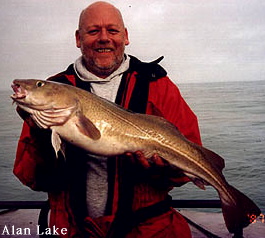Identification:
Classic codfish shape, with three rounded dorsal and two anal fins. The pelvic
fins are small with the first ray extended, and are set under the gill cover
(ie the throat region), in front of the pectorals. The upper jaw extends
over the lower jaw, which has a well developed chin barbel. Medium sized
eyes, approximately the same as the length of the chin barbel.
Distinct white lateral line running from the gill slit above the pectoral
fin, to the base of the caudal or tail fin. The back tends to be a greenish
to sandy brown, and showing extensive mottling especially towards the lighter
sides and white belly. Dark brown colouration of the back and sides is not
uncommon especially for individuals who have resided in rocky inshore regions.
Breeding:
The Cod population comprises of a number of
reasonably distinct stocks over it's range. These include the Arcto-Norwegian,
North Sea, Faroe, Iceland, East Greenland, West Greenland, Newfoundland,
and Labrador stocks. There would seem to be little interchange between
the stocks, although migrations to their individual breeding grounds may
involve distances of 200 miles or more.
Spawning occurs between January to April (March to April, is the peak
time), at a depth of 200m in specific spawning grounds at water
temperatures of between 4-6oC. Around the UK, the major ones are
associated with the Middle to Southern North Sea, the start of the Bristol
Channel (north of Newquay), The Irish Channel (both east and west of the
Isle of Man), around Stornoway, and east of Helmsdale.
Pre-spawning courtship involves fin displays, and male grunting, which leads
to pairing. The male is inverted underneath the female, whilst the pair
swim in circles during the spawning process. The eggs are planktonic
and hatch between 8 to 23 days with the larva being some 4mm in length.This
planktonic phase lasts some ten weeks, during which the young cod will increase
it's body weight by 40 times, and be about 2cm in length. The young cod move
to the seabed and their diet changes to small benthic crustaceans, such
as isopods and small crabs. They increase in size to 8cm in the first six
months, 14 to 18cm by the end of their first year, and some 25 to 35cm
by the end of the second. This rate of growth tends to be less in individuals
occupying northerly grounds.Cod reach maturity at about 50cm in length at
about 3 to 4 years of age.
Habitat:
Varied, although often favouring rough ground especially inshore. Demersal
in depths of between 20 to 200m (80m Av.), although not uncommon to depths
of 600m. Gregarious and forms schools, although shoaling tends to be
a feature of the spawning season.
Food:
Adult cod are active hunters, feeding on sandeels, whiting, haddock, small
cod, and squid, with a variety of benthic annelids, crustacea, and molluscs
supplementing their diets.
Range:
Throughout most of the UK waters, although generally
seen as a winter fish in the south.
Additional Notes:
Major commercial fish, although stocks have been damaged in the past
through over fishing.
Good eating.
|
|
Atlantic Cod (Boreogadus saida) |
|
|
|


